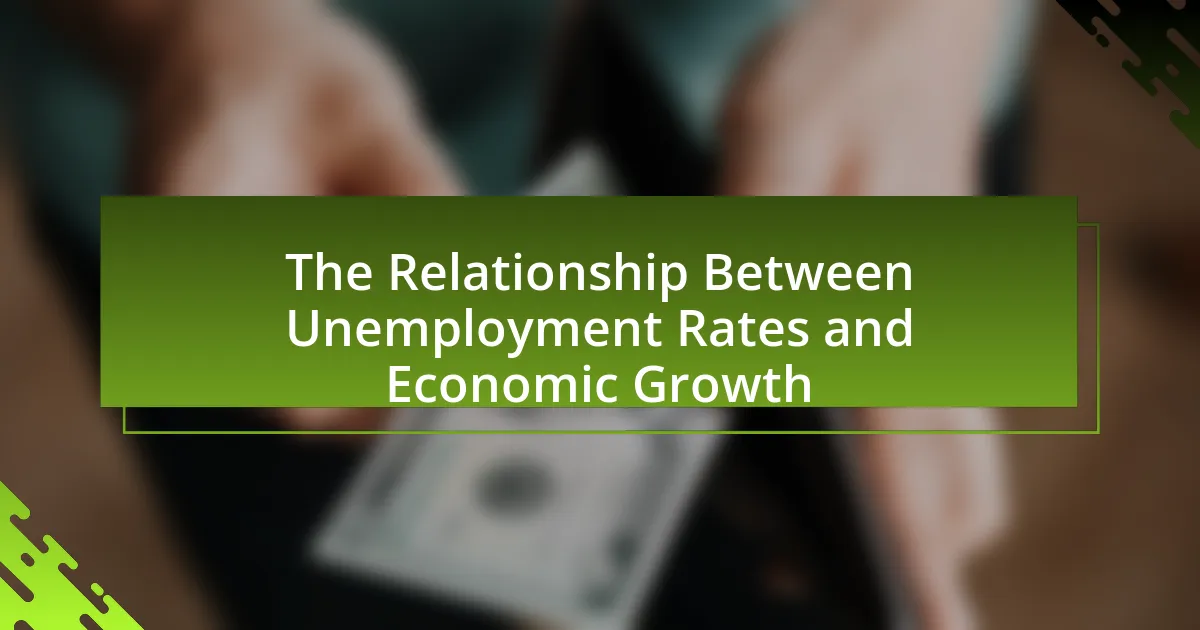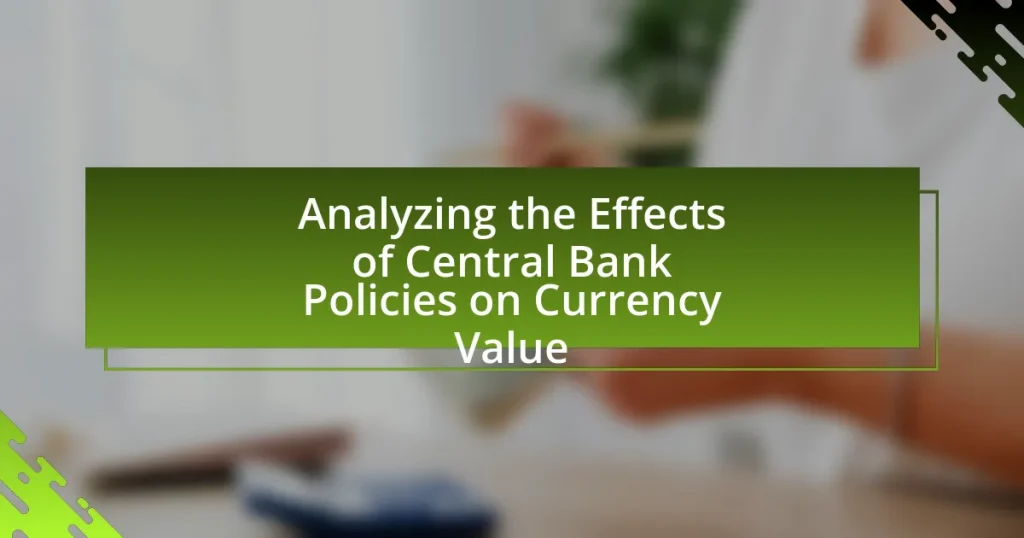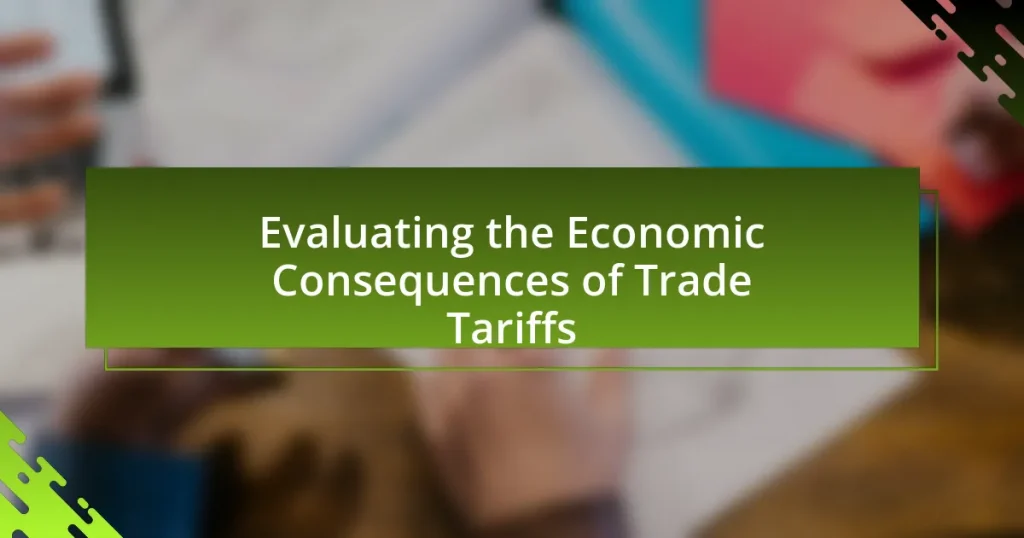The article examines the relationship between unemployment rates and economic growth, highlighting their inverse correlation as supported by Okun’s Law. It discusses how high unemployment negatively impacts economic growth by reducing consumer spending and productivity, while low unemployment fosters job creation and economic expansion. Key indicators of unemployment, such as the unemployment rate and labor force participation rate, are analyzed, along with the implications for policymakers and businesses. The article also explores external factors influencing this relationship, including economic cycles, government policies, and global economic conditions, emphasizing the importance of understanding these dynamics for effective economic strategies.
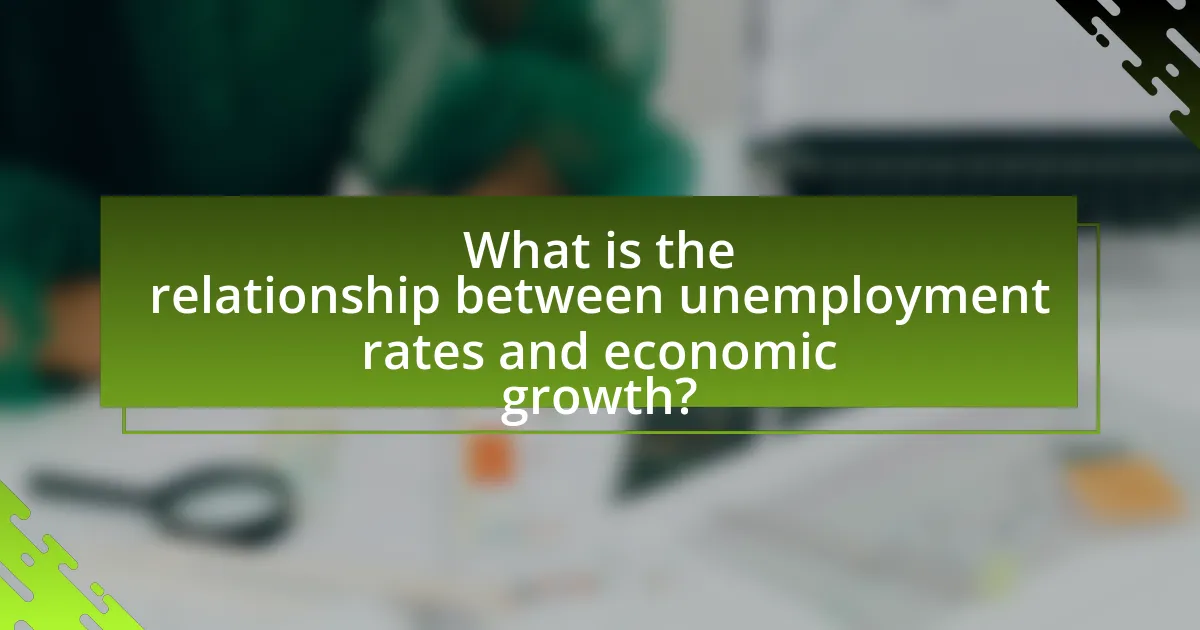
What is the relationship between unemployment rates and economic growth?
Unemployment rates and economic growth are inversely related; as economic growth increases, unemployment rates typically decrease. This relationship is supported by Okun’s Law, which states that a 1% decrease in unemployment is associated with a 2% increase in GDP. Historical data from various economies, such as the United States during the post-World War II expansion, demonstrates that periods of robust economic growth often coincide with declining unemployment rates, reinforcing the notion that higher economic activity leads to job creation.
How do unemployment rates influence economic growth?
Unemployment rates negatively influence economic growth by reducing consumer spending and overall productivity. When unemployment is high, fewer individuals have disposable income, leading to decreased demand for goods and services. For instance, during the 2008 financial crisis, the U.S. unemployment rate peaked at 10%, resulting in a significant contraction of GDP by 4.3% in 2009. This correlation indicates that as unemployment rises, economic growth typically slows due to diminished consumer confidence and spending power.
What are the key indicators of unemployment rates?
The key indicators of unemployment rates include the unemployment rate itself, labor force participation rate, and the number of job openings. The unemployment rate measures the percentage of the labor force that is jobless and actively seeking employment, which is a direct reflection of economic health. The labor force participation rate indicates the proportion of the working-age population that is either employed or actively looking for work, providing insight into the overall engagement of the workforce. Additionally, the number of job openings serves as an indicator of demand for labor, with higher job openings typically correlating with lower unemployment rates. These indicators collectively provide a comprehensive view of labor market conditions and their relationship to economic growth.
How do changes in unemployment rates affect consumer spending?
Changes in unemployment rates significantly affect consumer spending, as higher unemployment typically leads to reduced consumer confidence and lower disposable income. When unemployment rises, individuals face job insecurity, leading to decreased spending on non-essential goods and services. For instance, during the 2008 financial crisis, the U.S. unemployment rate peaked at 10%, resulting in a notable decline in consumer spending by approximately 3.5% in real terms. Conversely, when unemployment rates decrease, consumer confidence generally improves, leading to increased spending, as seen in the post-recession recovery period from 2010 to 2019, where a drop in unemployment from 10% to around 4% correlated with a rise in consumer spending by over 15%. This relationship underscores the direct impact of employment levels on economic activity and consumer behavior.
Why is understanding this relationship important?
Understanding the relationship between unemployment rates and economic growth is crucial because it directly influences policy-making and economic stability. High unemployment typically indicates underutilization of labor resources, which can hinder economic growth, while low unemployment often correlates with increased consumer spending and investment, driving economic expansion. For instance, the International Monetary Fund (IMF) has reported that a 1% decrease in unemployment can lead to a 2% increase in GDP, highlighting the significant impact of this relationship on overall economic health.
What implications does this relationship have for policymakers?
The relationship between unemployment rates and economic growth has significant implications for policymakers, as it informs their strategies for economic stability and job creation. High unemployment typically signals economic downturns, prompting policymakers to implement stimulus measures, such as increased public spending or tax cuts, to spur growth and reduce joblessness. Conversely, low unemployment may lead to inflationary pressures, necessitating tighter monetary policies to maintain economic balance. Historical data from the U.S. Bureau of Labor Statistics indicates that a 1% decrease in unemployment can correlate with a 2% increase in GDP, underscoring the importance of this relationship in shaping effective economic policies.
How can businesses benefit from understanding unemployment trends?
Businesses can benefit from understanding unemployment trends by making informed decisions regarding hiring, resource allocation, and market strategies. By analyzing unemployment data, companies can identify labor market conditions, which helps them anticipate talent availability and adjust their recruitment strategies accordingly. For instance, during periods of high unemployment, businesses may find it easier to attract skilled workers, while low unemployment may indicate a competitive labor market, prompting companies to enhance their compensation packages. Historical data shows that businesses that align their strategies with unemployment trends can improve operational efficiency and reduce costs associated with turnover and training.
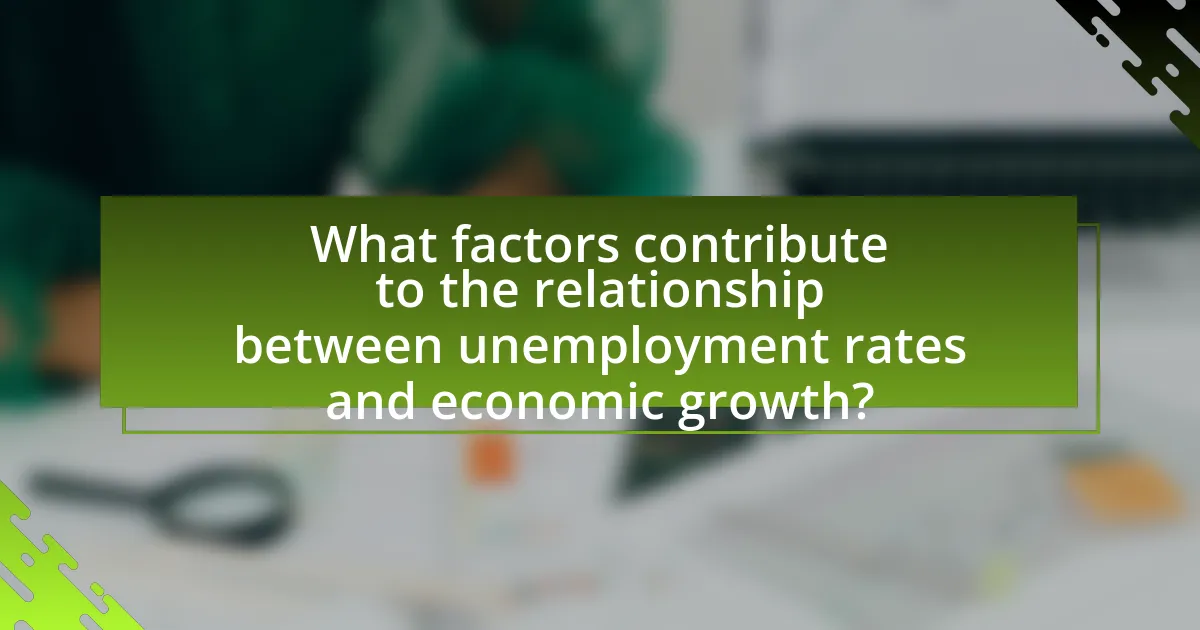
What factors contribute to the relationship between unemployment rates and economic growth?
The relationship between unemployment rates and economic growth is primarily influenced by labor market dynamics, productivity levels, and economic policies. High unemployment rates typically indicate underutilization of labor resources, which can hinder economic growth by reducing overall output and consumption. Conversely, low unemployment rates often correlate with increased consumer spending and higher productivity, driving economic expansion. For instance, during the economic recovery following the 2008 financial crisis, the U.S. experienced a decline in unemployment rates alongside GDP growth, demonstrating this relationship. Additionally, government policies such as fiscal stimulus and monetary easing can impact both unemployment and economic growth by influencing job creation and investment levels.
How do economic cycles impact unemployment rates?
Economic cycles significantly impact unemployment rates by causing fluctuations in job availability. During economic expansions, businesses experience growth, leading to increased hiring and lower unemployment rates; for instance, the U.S. unemployment rate fell to 3.5% in 2019 during a period of economic growth. Conversely, during recessions, businesses often reduce their workforce to cut costs, resulting in higher unemployment rates; for example, the unemployment rate peaked at 14.7% in April 2020 due to the COVID-19 pandemic’s economic impact. These patterns illustrate the direct correlation between economic cycles and employment levels, confirming that economic conditions are a primary driver of unemployment fluctuations.
What role do recessions play in increasing unemployment?
Recessions significantly increase unemployment by leading to reduced consumer spending and business investment. During a recession, economic activity slows down, causing companies to cut costs, often resulting in layoffs and hiring freezes. For instance, the Great Recession of 2007-2009 saw the U.S. unemployment rate peak at 10% as businesses faced declining revenues and reduced demand for goods and services. This correlation between economic downturns and rising unemployment is well-documented, with studies showing that each percentage point decline in GDP can lead to a corresponding increase in the unemployment rate by approximately 0.5 to 1 percentage points.
How does economic expansion affect job creation?
Economic expansion positively affects job creation by increasing demand for goods and services, which in turn leads businesses to hire more employees. As economies grow, companies experience higher revenues and profits, prompting them to invest in workforce expansion. For instance, during the economic expansion in the United States from 2010 to 2019, the unemployment rate fell from 9.9% to 3.5%, reflecting the creation of approximately 22 million jobs. This correlation demonstrates that as economic activity rises, job opportunities increase, reducing unemployment rates.
What external factors influence both unemployment and economic growth?
External factors that influence both unemployment and economic growth include global economic conditions, technological advancements, and government policies. Global economic conditions, such as recessions or booms in major economies, directly affect domestic job markets and growth rates; for instance, during the 2008 financial crisis, many countries experienced significant increases in unemployment alongside negative economic growth. Technological advancements can lead to job displacement in certain sectors while simultaneously creating new opportunities in others, impacting overall employment levels and productivity growth. Government policies, including fiscal stimulus measures or labor regulations, can either promote job creation and economic expansion or hinder them, as seen in various countries’ responses to economic downturns.
How do global economic conditions affect local unemployment rates?
Global economic conditions significantly influence local unemployment rates by affecting demand for goods and services, which in turn impacts job creation. For instance, during a global recession, reduced consumer spending leads to lower demand for products, prompting businesses to cut back on hiring or lay off employees. According to the International Labour Organization, the global unemployment rate rose by 5.7% in 2020 due to the COVID-19 pandemic, illustrating how interconnected economies can lead to local job losses. Conversely, when global economic conditions improve, increased trade and investment can stimulate local economies, resulting in job growth and lower unemployment rates.
What impact do government policies have on unemployment and growth?
Government policies significantly influence unemployment and economic growth by shaping labor market conditions and economic incentives. For instance, expansionary fiscal policies, such as increased government spending or tax cuts, can stimulate demand, leading to job creation and reduced unemployment. According to the International Monetary Fund, countries that implemented stimulus measures during economic downturns experienced faster recoveries and lower unemployment rates. Conversely, restrictive policies, such as austerity measures, can lead to higher unemployment and slower growth, as seen in the Eurozone during the financial crisis. Thus, the nature of government policies directly affects both unemployment levels and overall economic growth.
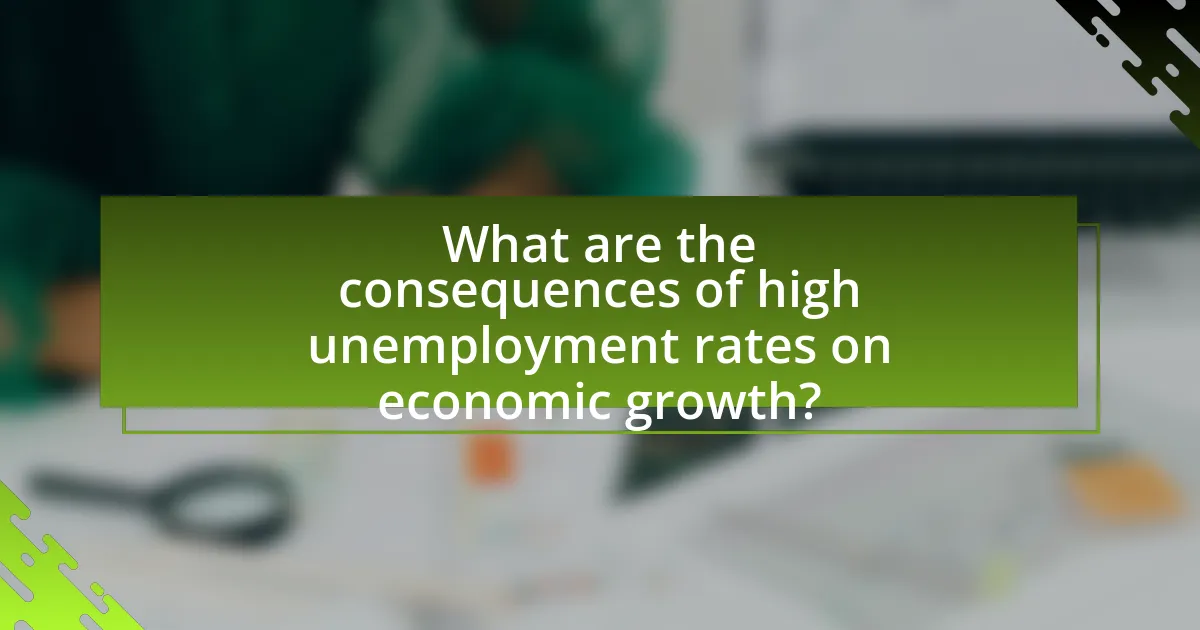
What are the consequences of high unemployment rates on economic growth?
High unemployment rates negatively impact economic growth by reducing consumer spending and overall productivity. When unemployment is high, a significant portion of the workforce is not earning income, leading to decreased demand for goods and services. For instance, during the 2008 financial crisis, the U.S. unemployment rate peaked at 10%, resulting in a GDP contraction of 4.3% in 2009, illustrating the direct correlation between rising unemployment and declining economic output. Additionally, prolonged high unemployment can lead to skill erosion among workers, further diminishing productivity and hindering economic recovery.
How does high unemployment affect overall economic productivity?
High unemployment negatively impacts overall economic productivity by reducing the labor force’s effective contribution to economic output. When a significant portion of the workforce is unemployed, the economy operates below its potential capacity, leading to lower gross domestic product (GDP). For instance, during the 2008 financial crisis, the U.S. unemployment rate peaked at 10%, resulting in an estimated GDP loss of approximately $1.3 trillion, according to the Congressional Budget Office. This illustrates that high unemployment not only diminishes individual income and consumption but also hampers business investment and innovation, further stalling economic growth.
What are the long-term effects of sustained high unemployment?
Sustained high unemployment leads to significant long-term economic and social consequences. Economically, it results in decreased consumer spending, which can slow down economic growth and lead to a prolonged recession. For instance, during the Great Recession, the U.S. experienced unemployment rates above 10% for several years, contributing to a slow recovery and long-term GDP losses estimated at $1.5 trillion. Socially, high unemployment can lead to increased poverty rates, mental health issues, and a decline in overall well-being, as seen in studies indicating that prolonged unemployment is linked to higher rates of depression and anxiety. Additionally, it can create a skills gap, where workers become less employable over time due to lack of experience, further entrenching economic disparities.
How does high unemployment impact social stability and consumer confidence?
High unemployment negatively impacts social stability and consumer confidence by increasing economic insecurity and social unrest. When unemployment rates rise, individuals face financial difficulties, leading to heightened stress and anxiety, which can result in increased crime rates and social discord. For instance, a study by the International Labour Organization in 2020 found that a 1% increase in unemployment can lead to a 0.5% increase in crime rates. Additionally, consumer confidence declines as job security diminishes; according to the Conference Board, consumer confidence typically falls during periods of high unemployment, as people are less willing to spend money when they fear losing their jobs. This cycle of reduced spending further exacerbates economic downturns, creating a feedback loop that destabilizes both social structures and economic growth.
What strategies can be employed to mitigate the negative effects?
To mitigate the negative effects of unemployment on economic growth, targeted government policies such as job creation programs, vocational training, and unemployment benefits can be employed. Job creation programs stimulate demand for labor, directly reducing unemployment rates. Vocational training equips individuals with skills that match market needs, enhancing employability and productivity. Unemployment benefits provide financial support, allowing individuals to sustain consumption levels, which in turn supports economic stability. Research indicates that countries implementing such strategies have experienced faster economic recovery and lower unemployment rates, demonstrating their effectiveness in addressing the adverse impacts of unemployment on economic growth.
How can job training programs reduce unemployment rates?
Job training programs can reduce unemployment rates by equipping individuals with the skills and knowledge necessary to meet the demands of the job market. These programs enhance employability by providing targeted training that aligns with industry needs, thereby increasing the likelihood of job placement. For instance, a study by the National Bureau of Economic Research found that participants in job training programs experienced a 10% increase in employment rates compared to non-participants. This evidence demonstrates that effective job training can bridge the skills gap, leading to lower unemployment rates and contributing positively to economic growth.
What role does government intervention play in stimulating economic growth?
Government intervention plays a crucial role in stimulating economic growth by implementing policies that enhance aggregate demand and improve market conditions. For instance, during economic downturns, governments often increase public spending on infrastructure projects, which creates jobs and boosts consumer spending. Historical evidence from the 2008 financial crisis shows that stimulus packages, such as the American Recovery and Reinvestment Act, contributed to a significant reduction in unemployment rates and fostered economic recovery. Additionally, government interventions, such as tax incentives for businesses, can encourage investment and innovation, further driving economic growth.
What best practices can businesses adopt in response to unemployment trends?
Businesses can adopt flexible workforce strategies in response to unemployment trends. By implementing practices such as remote work options, part-time roles, and contract positions, companies can adjust their labor needs according to economic conditions. For instance, during economic downturns, businesses that offer flexible employment can retain talent while minimizing costs, as evidenced by a 2021 report from the Bureau of Labor Statistics indicating that companies with adaptable work arrangements experienced lower turnover rates. Additionally, investing in employee training and development can enhance workforce skills, making employees more valuable and adaptable to changing market demands. This approach not only helps businesses remain competitive but also supports the overall economy by fostering a skilled labor force.
